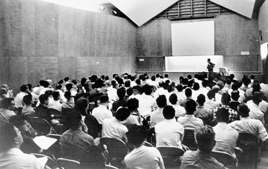1962: Basic Mechanisms in Animal Virus Biology, Vol. XXVII
Organizer: Arthur Chovnick
The 1953 Symposium, Viruses, had dealt to a very large extent with bacteriophage genetics and life-cycle, and, as Dulbecco wrote in his concluding remarks to the 1962 Symposium, the animal virologists at the earlier meeting "...can perhaps recall the feeling of isolation they felt at that time." Times had changed and the rather prosaic title of the 1962 Symposium belied the extraordinary nature of this meeting. The ability to grow viruses in animal cells in culture had transformed the field, producing large amounts of virus for physical and chemical analysis, as well as providing a dynamic system for the analysis of the virus life cycle. Dulbecco marvelled that not only was it possible to devote a whole symposium to viruses, but also that "...the experiments reported are as sophisticated as those obtained in any other field of biology..."
Reading the papers in the Symposium volume suggests that Dulbecco need not have belabored this point. The volume opens with a classic paper by Donald Caspar and Aaron Klug on the common geometrical principles underlying the structures of the protein coats of viruses, whether tube-like (for example, Tobacco mosaic virus) or polyhedral (for example, Turnip Yellow mosaic virus). (The inspiration for the latter came from the geodesic domes of Buckminster Fuller.)
In the 1960s, before the advent of recombinant DNA techniques, there were hopes that the viruses causing tumors in animals would provide insights into the genetics of cancer. How was it that a virus with so few genes could bring about such extraordinary changes in a cell? At the time of the Symposium this was a question that had hardly been touched on, and most of the papers were descriptions of the various virus-cell combinations being studied. The
| 
authors of these papers read like a roll call of those who would lay the foundations of tumor virology in the coming years; Marguerite Vogt, Renato Dulbecco, Michael Stoker, Peter Vogt, Harry Rubin, and Howard Temin.
There were two papers added to the original program for the meeting. One was a short, one-page document by Caspar, Dulbecco, Klüg, Lwoff, Stoker, Tournier and Wildy proposing and defining a set of terms for use in virology. The second was an attempt by Lwoff to devise a standardized and rational classification of viruses. This was based first on whether a virus has a DNA or RNA genome; second, the symmetry of the capsid; third, whether the capsid is naked or enveloped, and so on. Wildy responded rather strongly to what he saw as an arbitrary scheme that was not meaningful.
We can see, with the wisdom that comes with hindsight, that this Symposium leaves us with tantalizing glimpses of how research on tumor viruses was going to progress. It would be twelve years before many of these same researchers returned to Cold Spring Harbor for the Symposium that would deal specifically with Tumor Viruses.
— Jan A. Witkowski |